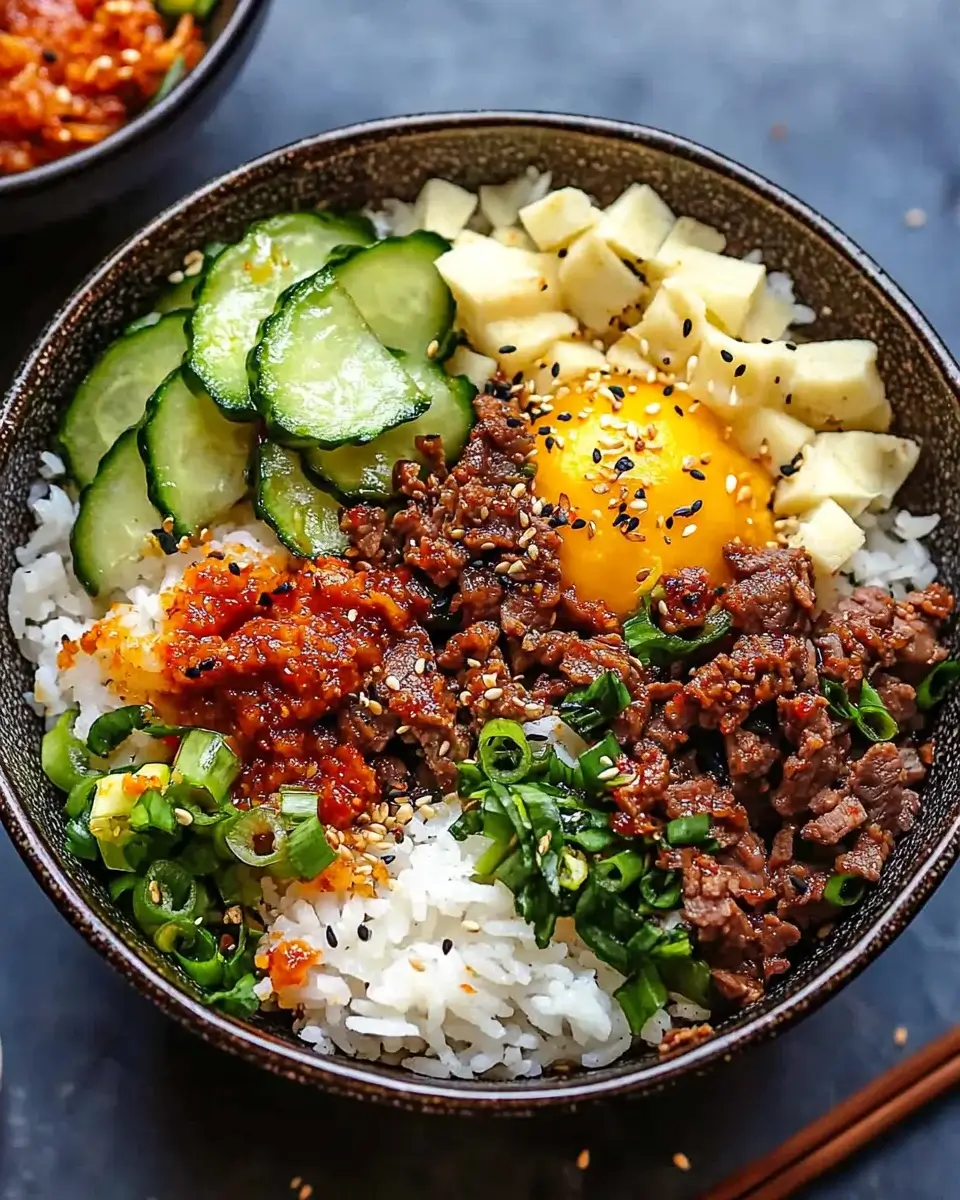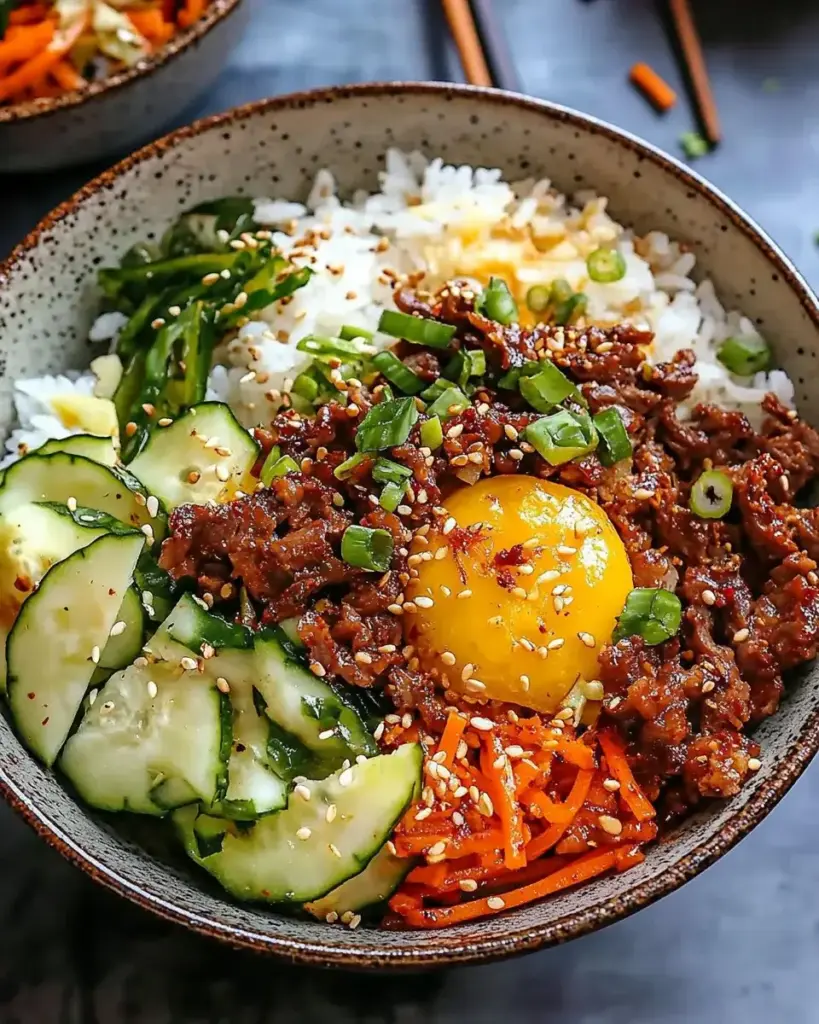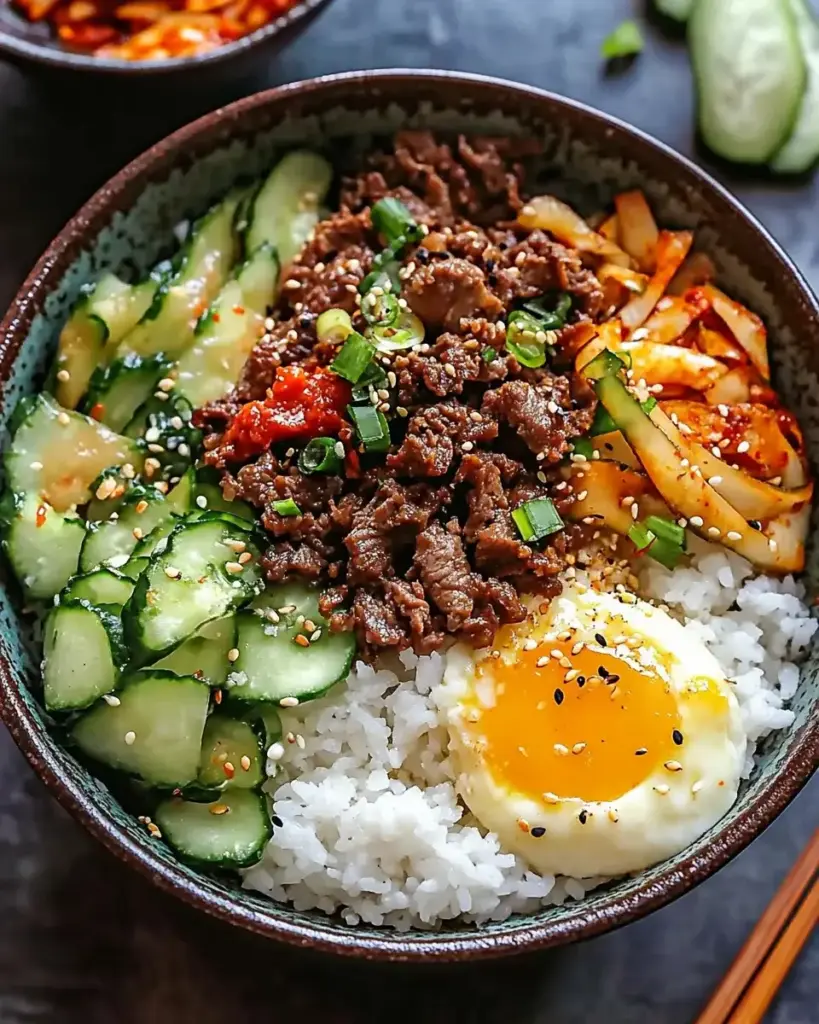
Introduction to Gochujang Beef Rice Bowls
After a long day, the last thing I want is to spend hours in the kitchen. That’s where Gochujang Beef Rice Bowls come to the rescue! This dish is a delightful blend of savory ground beef, vibrant veggies, and a spicy gochujang sauce, all served over fluffy rice. It’s not just a meal; it’s a quick solution for busy weeknights or a way to impress your loved ones with minimal effort. Trust me, once you try this recipe, it’ll become a staple in your dinner rotation. Let’s dive into this delicious adventure!
Why You’ll Love This Gochujang Beef Rice Bowls
These Gochujang Beef Rice Bowls are a game-changer for your weeknight dinners. They come together in just 30 minutes, making them perfect for those hectic evenings. The combination of flavors is simply irresistible—spicy, savory, and oh-so-satisfying. Plus, you can customize them with your favorite veggies or proteins. It’s a dish that not only fills your belly but also warms your heart. What’s not to love?
Ingredients for Gochujang Beef Rice Bowls
Gathering the right ingredients is key to making these Gochujang Beef Rice Bowls a hit. Here’s what you’ll need:
- Ground beef: The star of the dish, providing a rich, savory flavor. You can also use ground turkey or chicken for a leaner option.
- Vegetable oil: This helps sauté the aromatics and beef. Feel free to swap it with olive oil or sesame oil for added flavor.
- Onion: Diced onion adds sweetness and depth. Yellow or white onions work best.
- Garlic: Minced garlic brings a punch of flavor. Fresh is always best, but jarred can work in a pinch.
- Ginger: Fresh ginger adds a warm, zesty kick. If you don’t have fresh, ground ginger can be a substitute.
- Gochujang: This Korean chili paste is the secret sauce! It’s spicy, sweet, and umami-rich. You can find it in most grocery stores or Asian markets.
- Soy sauce: Adds saltiness and depth. For a gluten-free option, use tamari.
- Brown sugar: Balances the heat from the gochujang. You can use honey or maple syrup as alternatives.
- Sesame oil: A drizzle of this oil enhances the dish with a nutty flavor. It’s optional but highly recommended.
- Cooked rice: The base of the bowl. White or brown rice works well, and you can even use quinoa for a twist.
- Broccoli florets: Steamed broccoli adds color and nutrition. Feel free to swap with other veggies like bell peppers or snap peas.
- Shredded carrots: These add crunch and sweetness. You can use pre-shredded carrots for convenience.
- Green onions: Sliced green onions provide a fresh, crisp finish. Chives can be a good substitute.
- Sesame seeds: For garnish, these add a nice touch of flavor and texture.
For exact measurements, check the bottom of the article where you can find a printable version of the recipe!
How to Make Gochujang Beef Rice Bowls
Creating these Gochujang Beef Rice Bowls is a breeze! Follow these simple steps, and you’ll have a delicious meal ready in no time. Let’s get cooking!
Step 1: Sauté the Aromatics
Start by heating the vegetable oil in a large skillet over medium heat. Once hot, toss in the diced onion. Sauté for about 3 minutes until the onion is softened and translucent. This step builds a flavorful base for your dish.
Step 2: Add Garlic and Ginger
Next, stir in the minced garlic and ginger. Cook for an additional minute until fragrant. The aroma will fill your kitchen, making it hard to resist diving in already!
Step 3: Cook the Ground Beef
Now, add the ground beef to the skillet. Break it apart with a spatula and cook until browned, about 5-7 minutes. Don’t forget to drain any excess fat to keep your dish light and tasty.
Step 4: Mix in the Sauce
Time to bring the flavor! Stir in the gochujang, soy sauce, brown sugar, and sesame oil. Let it simmer for 2-3 minutes. This is where the magic happens, as the ingredients meld together into a savory sauce.
Step 5: Steam the Vegetables
While the beef mixture simmers, steam the broccoli florets until tender, about 4-5 minutes. You want them bright green and slightly crisp for that perfect texture contrast.
Step 6: Assemble the Bowls
Now, it’s time to put it all together! Divide the cooked rice among four bowls. Top each bowl with the gochujang beef mixture, steamed broccoli, and a handful of shredded carrots. It’s a colorful feast!
Step 7: Garnish and Serve
Finally, garnish your bowls with sliced green onions and a sprinkle of sesame seeds. This adds a lovely crunch and a pop of flavor. Serve immediately and enjoy your homemade Gochujang Beef Rice Bowls!

Tips for Success
- Prep your ingredients ahead of time to streamline the cooking process.
- Don’t rush the sautéing; it builds flavor in your Gochujang Beef Rice Bowls.
- Adjust the gochujang to your spice preference—start with less if you’re unsure!
- Use leftover rice for a quicker meal; it reheats beautifully.
- Experiment with different veggies to keep things fresh and exciting.
Equipment Needed
- Large skillet: Essential for cooking the beef and veggies. A non-stick pan works well too.
- Spatula: Perfect for breaking up the beef and stirring the mixture.
- Steamer basket: For steaming broccoli; a microwave-safe bowl with a lid can work in a pinch.
- Measuring spoons: Handy for accurate ingredient measurements.
Variations
- Protein Swap: Use ground turkey, chicken, or even tofu for a vegetarian option. Each brings a unique flavor to the dish.
- Spice Level: For a fiery kick, add extra gochujang or toss in some sliced jalapeños. Adjust to your heat preference!
- Veggie Medley: Mix in bell peppers, snap peas, or zucchini for added color and nutrition. The more, the merrier!
- Rice Alternatives: Try quinoa or cauliflower rice for a low-carb twist. Both options are delicious and filling.
- Flavor Boost: Add a splash of rice vinegar or lime juice for a tangy finish that brightens the dish.
Serving Suggestions
- Side Dishes: Pair your Gochujang Beef Rice Bowls with a simple cucumber salad for a refreshing crunch.
- Drinks: Enjoy with a cold beer or a light, fruity iced tea to balance the spice.
- Presentation: Serve in colorful bowls and add extra sesame seeds for a beautiful finish.

FAQs about Gochujang Beef Rice Bowls
Can I make Gochujang Beef Rice Bowls ahead of time?
Absolutely! You can prepare the beef mixture and steam the vegetables in advance. Just store them separately in the fridge. When you’re ready to eat, reheat everything and assemble your bowls. It’s a great way to save time on busy nights!
Is this recipe gluten-free?
Yes, Gochujang Beef Rice Bowls can be gluten-free! Just make sure to use gluten-free soy sauce or tamari. The rest of the ingredients are naturally gluten-free, so you can enjoy this dish without worry.
What can I substitute for gochujang?
If you can’t find gochujang, you can use a mix of miso paste and chili powder as a substitute. It won’t be exactly the same, but it will still give you a nice depth of flavor. Just adjust the quantities to your taste!
How spicy are these bowls?
The spice level of Gochujang Beef Rice Bowls can vary based on how much gochujang you use. It’s generally mild to medium, but you can always add more for a kick. If you’re sensitive to spice, start with a smaller amount and adjust as needed.
Can I use other proteins in this recipe?
Definitely! Ground turkey, chicken, or even tofu work well in this recipe. Each option brings its own unique flavor and texture, so feel free to experiment and find your favorite!
Final Thoughts
Cooking Gochujang Beef Rice Bowls is more than just preparing a meal; it’s about creating a moment of joy in your kitchen. The vibrant colors, enticing aromas, and bold flavors come together to make a dish that’s both comforting and exciting. Whether you’re sharing it with family or enjoying a solo dinner, each bite is a reminder of how simple ingredients can create something extraordinary. Plus, the ease of preparation means you can savor the experience without the stress. So, roll up your sleeves, embrace the spice, and let these bowls bring warmth to your table!
Gochujang Beef Rice Bowls are a delicious weeknight meal!
Ingredients
Method
- In a large skillet, heat the vegetable oil over medium heat. Add the diced onion and sauté for about 3 minutes until softened.
- Stir in the minced garlic and ginger, cooking for an additional minute until fragrant.
- Add the ground beef to the skillet, breaking it apart with a spatula. Cook until browned and fully cooked, about 5-7 minutes. Drain any excess fat.
- Stir in the gochujang, soy sauce, brown sugar, and sesame oil. Mix well and let it simmer for about 2-3 minutes to combine the flavors.
- While the beef mixture simmers, steam the broccoli florets until tender, about 4-5 minutes.
- To assemble the bowls, divide the cooked rice among four bowls. Top with the gochujang beef mixture, steamed broccoli, and shredded carrots.
- Garnish with sliced green onions and sesame seeds before serving.
Nutrition
Notes
- For a spicier kick, add extra gochujang or a sprinkle of red pepper flakes to the beef mixture.
- Substitute ground turkey or chicken for a leaner option, or use tofu for a vegetarian version.


